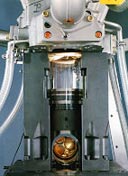
The Combustion Research Facility (CRF) at Sandia National Laboratories has been working closely with U.S. engine manufacturers for more than 25 years to increase scientific understanding of the internal combustion engine processes that affect efficiency and emissions. Currently, most engine research is directed toward building the science base needed to enable high-efficiency engine designs using ultralow-emission, low-temperature combustion, and advanced diesel combustion systems. Target vehicles include passenger cars, light-duty trucks, sport utility vehicles, and heavy-duty transport vehicles.
CRF researchers use advanced, laser-based diagnostics in conjunction with experimental hardware that simulates or closely mimics realistic engine conditions. Research hardware includes several optically accessible, single-cylinder engines with production or prototypical engine heads and an optically accessible combustion vessel capable of simulating an extremely wide range of potential engine conditions. Optical access in the engines is provided by quartz piston heads, quartz cylinder liners, windowed spacers, and/or periscopes in exhaust valves. CRF engine researchers are also developing sensitive, high-energy, laser-based diagnostics for measuring real-time particulate matter in engine exhaust streams.
Sandia’s engine combustion research program is sponsored by the Department of Energy’s Office of FreedomCAR and Vehicle Technologies. The work is conducted in close cooperation with U.S. automotive and heavy-duty diesel engine industries, other national laboratories, and universities.

The homogeneous-charge compression ignition (HCCI) engine has caught the attention of automotive and diesel engine manufacturers worldwide because of its potential to rival the high efficiency of diesel engines while keeping nitrogen oxides (NOx) and particulate emissions extremely low. Researchers must overcome several technical barriers, such as controlling ignition timing, reducing unburned hydrocarbon and carbon monoxide emissions, extending operation to higher loads, and maintaining combustion stability through rapid transients.
The CRF’s Automotive HCCI Engine Laboratory houses a versatile light-duty engine designed to allow investigations of a wide variety of issues for this type of HCCI application. Researchers are using laser elastic scatter and laser-induced fluorescence imaging to study the distribution of both liquid- and vapor-phase fuel in the cylinder from the time of injection to the time of ignition.
Reducing greenhouse gas emissions and U.S. reliance on foreign oil imports is a strong driver for increasing the fuel efficiency of passenger cars and light-duty trucks. While the increased use of diesel engines in these vehicles is likely the fastest route toward achieving this goal, relatively high emissions of NOx and particulate matter impede the widespread adoption of such vehicles. Research into automotive-class diesel engines is focused on low-temperature combustion techniques that can reduce emissions in-cylinder without sacrificing engine efficiency and fuel consumption.
Fuel composition can have a profound impact on the performance of direct-injection (DI) diesel engines, including soot emissions, cold-start characteristics, and compatibility with exhaust-gas aftertreatment systems. The addition of oxygen-containing compounds, known as “oxygenates,” to diesel fuel can dramatically lower soot emissions. Past research conducted at the CRF has shown that an oxygenate’s molecular structure can have a significant impact on its ability to eliminate soot.

Fuel formulation is especially important for new engines that will operate in low-temperature combustion (LTC) regimes because chemical-kinetic processes that are strongly dependent on fuel type largely control the limiting processes of ignition and heat release rate. LTC modes such as HCCI are of considerable interest because they can simultaneously reduce NOx and soot emissions by two orders of magnitude while maintaining high thermal efficiency. LTC can currently be achieved only over a limited portion of an engine’s typical operating range.
Current fuels research is focused on developing a fundamental understanding of the combustion characteristics of advanced liquid petroleum-based, bio-derived, and synthetic fuels and applying this knowledge to the following:
The Fuels Research Laboratory is built around the Sandia compression-ignition optical research engine (SCORE). SCORE is a single-cylinder version of a Caterpillar® C 10 engine that has been modified at Sandia to provide extensive optical access into the combustion chamber. Considerable design and development work has been done to enable the precise control of important operating parameters to ensure exceptional experiment repeatability.
The fuels research project facilitates efficient and rapid progress toward the commercialization of optimal fuel and engine technologies by publishing research results in open literature and through close collaborations with engine manufacturers, energy companies, other government laboratories, and academia.
Contact Craig Smith at (925) 294-3358 for more information on partnering opportunities with Sandia’s Transportation-Based Energy Systems group.